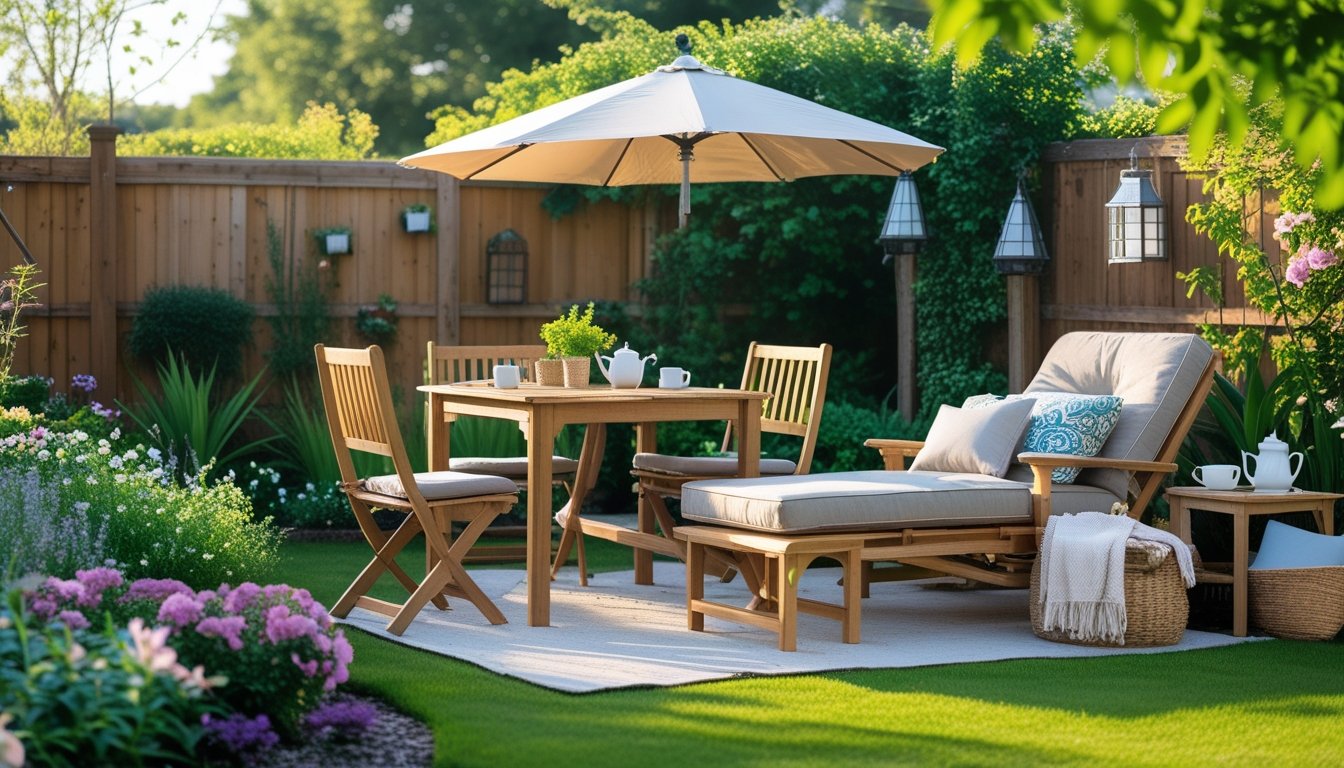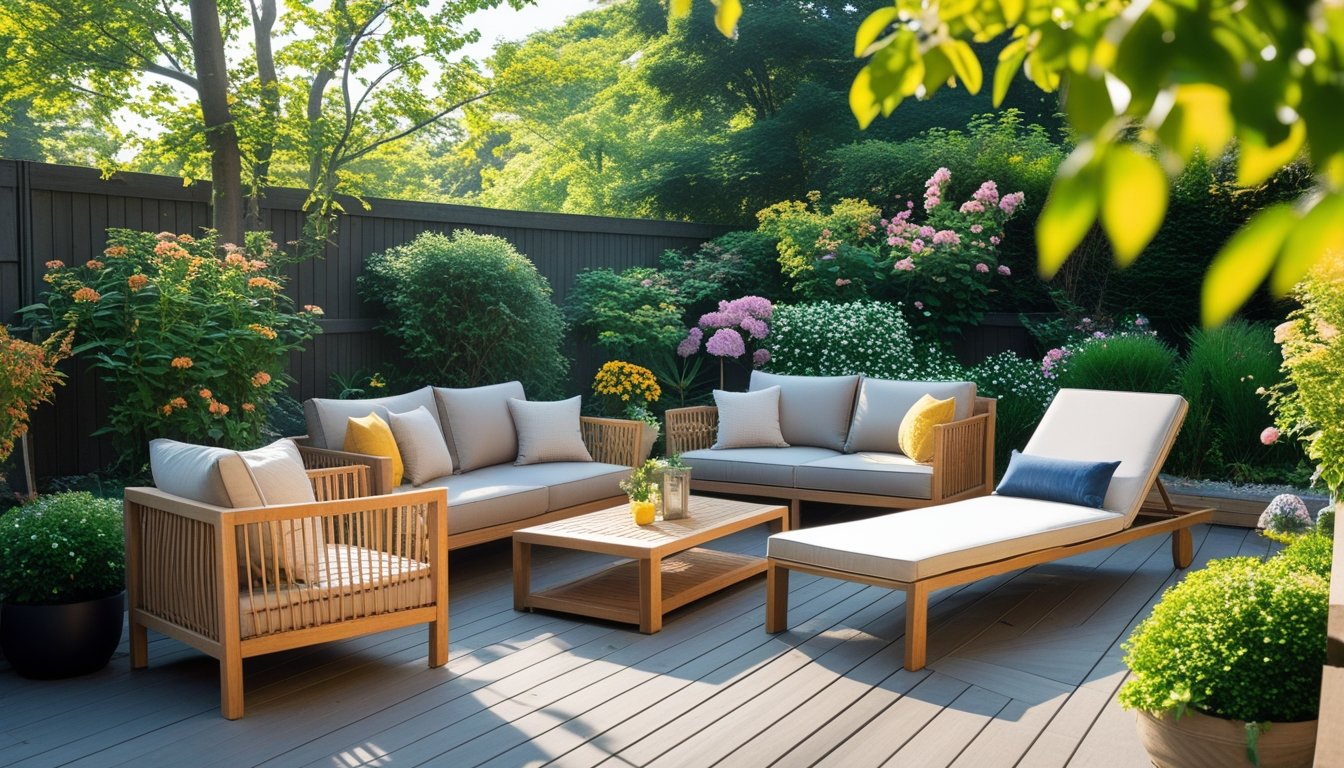Late updated: 15 Nov 2025 08:11
Written by: James Whitaker
Essential Garden Furniture Choices For Comfort: Making the Right Selections
Creating an inviting outdoor space is all about choosing the right garden furniture. As the seasons change, so do our preferences and needs for comfort in the garden. Whether it’s lounging under a summer sun or enjoying a crisp autumn evening, selecting the proper furniture transforms a basic patio into a serene retreat. The most important aspect to focus on is finding comfortable, durable furniture that withstands the elements while enhancing the aesthetics of your garden.

Navigating the myriad options can be daunting, but understanding comfort and functionality ensures we make informed choices that fit our lifestyle and space. Patio and garden furniture comes in various styles and materials, each offering unique benefits. Our task is to evaluate these options thoughtfully to create a cohesive, functional, and stylish outdoor environment.
Once equipped with the right information on materials and features, we are empowered to make decisions that align with both our comfort needs and design preferences. By prioritising quality and comfort, our garden becomes not only a place of beauty but a sanctuary for relaxation and social gatherings.
Key Takeaways
- Comfortable and durable furniture is vital for a functional outdoor space.
- Evaluating styles and materials ensures we create a suitable garden environment.
- Quality selections transform gardens into inviting sanctuaries.
Core Elements of Essential Garden Furniture Choices

To truly enjoy an outdoor space, selecting the right garden furniture is key. Focusing on comfort, style, and durability transforms a simple garden into a haven. Let's delve into the fundamental aspects that can help us make the right choices.
Types of Garden Furniture for Comfort
Garden furniture comes in various types, each serving a distinctive purpose. Garden sofas, loveseats, and sectional seating offer flexibility and are ideal for lounging. Dining sets transform spaces into alfresco dining areas. Loungers and hammocks provide relaxation and serenity. Choosing the right types involves considering the intended use of your garden and how each piece complements the space.
Modular pieces, in particular, adapt to different settings, offering varied seating arrangements to suit occasions. Consider how each piece fits into the layout, ensuring ease of movement and optimal comfort for gatherings or solitary retreats.
Choosing the Best Materials for Outdoor Relaxation
Selecting the best materials is essential for durability and comfort. Wooden furniture, like teak or cedar, offers a classic look and high resilience against the elements but requires regular maintenance. Metal furniture, such as aluminium or wrought iron, is strong and can be less demanding in upkeep if powder-coated.
Rattan and wicker are popular for their lightweight and aesthetic appeal, however, synthetic versions offer superior weather resistance. PVC and resin options bring in affordability and low maintenance. Our aim should be to choose materials that complement the garden style and withstand various weather conditions throughout the year.
Garden Sofas and Outdoor Seating Essentials
Garden sofas form the backbone of comfortable outdoor seating. When selecting sofas, we should focus on size, style, and functionality. Sectional garden sofas provide flexible seating arrangements, perfect for hosting gatherings. Daybeds and chaise lounges enhance relaxation, offering comfort akin to indoor spaces.
The right choice hinges on intended use and available space. Perhaps a small corner with a cosy two-seater for intimate moments or a larger sectional for family gatherings. It's about balancing aesthetics with practicality, ensuring every piece enhances the garden's allure and utility.
Importance of Outdoor Cushions and Textiles
Outdoor cushions and textiles dramatically affect the comfort and style of garden furniture. Cushions provide essential support, and choosing coverings made from weather-resistant materials like Sunbrella fabric extends their life and maintains colour vibrancy.
Patterns and colours can set a tone – neutral hues offer a serene vibe, while bold designs can uplift and invigorate the space. Regular maintenance, like cleaning and seasonal storage, preserves their allure. Accessories such as throws and pillows not only add layers of comfort but also personalise the patio or garden, reflecting our unique style preferences.
Evaluating Material Options and Comfort Features
In creating a comfortable and stylish garden space, choosing the right materials is key. Our focus covers various options like rattan, hardwoods, metal, and fabrics, each offering distinct benefits and considerations.
Rattan and Synthetic Rattan Furniture Benefits
Rattan garden furniture stands out for its natural beauty and flexibility. Rattan is prized for its ability to blend seamlessly with garden settings, providing an elegant and earthy feel. However, natural wicker demands upkeep to prevent brittleness over time.
For durability and low maintenance, synthetic rattan is a popular choice. Made from materials like polyethylene, it mimics the look of natural rattan but offers superior resistance to weather conditions. Synthetic rattan doesn't fade easily under the sun and withstands rain without rotting. Whether opting for natural or synthetic, these choices provide comfort with their intertwined designs that support various cushions effortlessly.
Hardwoods, Teak, and Eucalyptus Choices
Hardwood furniture, featuring woods like teak and eucalyptus, is revered for its durability and aesthetic appeal. Teak is particularly robust and weather resistant, thanks to its natural oils that repel water and prevent decay.
Eucalyptus offers similar benefits at a more affordable price, with rich tones that add warmth to any space. Regular oiling enhances the wood’s resilience and appearance. Although hardwoods come at a higher cost, the longevity and classic style they offer can make them a worthwhile investment for garden furniture. They typically pair well with neutral cushions to enhance comfort without overshadowing the wood's rich texture.
Comparing Metal, Wooden, and Plastic Options
Metal garden furniture, particularly aluminium, provides durability and sleek design. Aluminium is lightweight and resists rust, making it practical for various outdoor settings. Steel offers strength but requires protective coatings to avoid rust.
When comparing metals to wooden garden furniture, the latter is often heavier and can require more maintenance. However, wood introduces a natural appeal that metal lacks. Meanwhile, plastic garden furniture offers a budget-friendly alternative. It is easy to clean, lightweight, and available in a range of colours, though it can lack the sturdiness of metal or wood. Each material offers distinct advantages depending on the priorities of style, maintenance, and budget.
Selecting Weatherproof Parasols and Durable Fabrics
Weather protection is critical for enjoying garden furniture comfortably in all conditions. Investing in weatherproof parasols shields from UV rays and rain, while also contributing to the garden’s aesthetic.
Fabrics used in outdoor settings must withstand climate challenges. Sunbrella fabric, known for its resilience, resists fading and mildew, making it an excellent choice for cushions and parasols. This fabric’s adaptability to different styles ensures elegance and functionality, enhancing the comfort of any garden setup. Opting for durable, quality fabrics is a straightforward way to prolong the life of garden furniture while keeping it looking fresh.
Frequently Asked Questions

Navigating the realm of garden furniture involves finding pieces that are comfortable, weather-resistant, and stylish. We explore essential considerations such as material durability, design appeal, and maintenance tips to make informed choices.
What are the must-have pieces of furniture for a comfortable garden setup?
A classic garden setup often includes a combination of seating options like sofas or benches, a dining table with chairs, and lounge chairs for relaxation. Weather-proof cushions and a parasol can further enhance comfort.
How do I choose garden furniture that will stand up to changing weather conditions?
Materials play a crucial role in weather resistance. Teak, aluminium, and all-weather wicker are among the durable options. We recommend protective covers to extend the life of the furniture, especially in harsh climates.
In what ways can I ensure my outdoor seating is both comfortable and stylish?
Combining comfort and style involves selecting pieces with ergonomic designs and using plush cushions. Opt for colours and patterns that complement your garden's aesthetic, and consider modular furniture for flexibility in arrangement.
Could you recommend types of material for durable and long-lasting garden furniture?
Teak is renowned for its longevity and resistance to weathering. Aluminium is lightweight yet sturdy, while synthetic rattan offers a durable yet stylish appeal. These materials require minimal maintenance, making them ideal for lasting garden furniture.
What are the key considerations when selecting furniture for a small garden or patio?
Space is a premium in smaller areas, so we suggest choosing multifunctional or foldable furniture to maximise space. Vertical shelving or wall-mounted solutions can also offer additional utility without taking up floor space.
How often should garden furniture be replaced to maintain comfort and aesthetics?
Regular maintenance can prolong the life of garden furniture, yet inevitable wear may require replacements every 5 to 10 years. Inspect for signs of wear, such as rust or faded upholstery, to determine the need for replacement.
